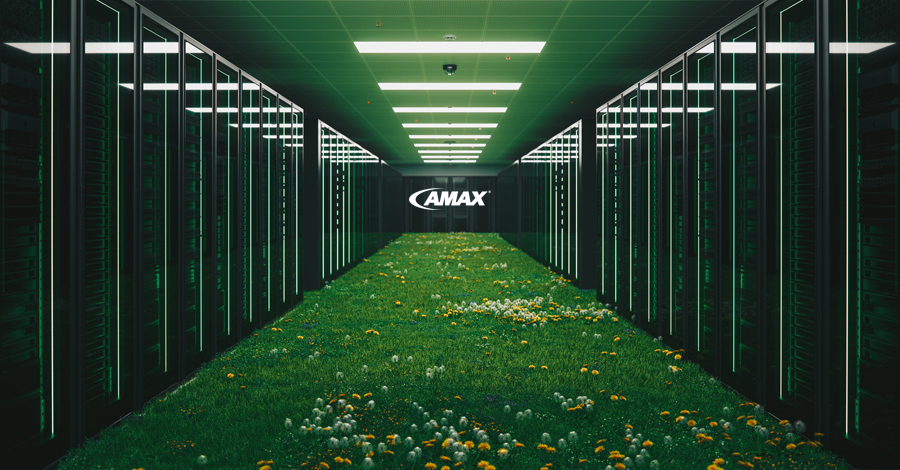
Transforming Data Centers Toward a Future of Sustainability
Modern life has become profoundly intertwined with data and the digital realm. Behind every search, stream, and share is a vast and complex infrastructure that makes it all possible. However, while data centers provide indispensable services, their environmental impact can be staggering. The International Energy Agency (IEA) reports that the demand from data centers accounts for 1-1.5% of global electricity use and is responsible for 1% of energy-related greenhouse gas (GHG) emissions (1). Understanding the growing environmental impact of data centers is a critical aspect of addressing sustainability challenges. These IT infrastructures are major energy consumers, and their traditional cooling systems contribute to significant water usage per year. Additionally, the production, utilization, and disposal of data center hardware contributes to e-waste, a pressing environmental concern. To align with sustainability goals of the future, we must begin by redesigning the infrastructure of data centers today.
AMAX Commitment to Sustainability
At AMAX, we are committed to developing and implementing cutting-edge solutions that significantly reduce the environmental impact of data centers. We design and optimize data center power usage effectiveness (PUE) to reach a ratio below 1.03, significantly below the global average of 1.55 (2). Through our innovative advanced computing technologies, we aim to redefine what’s possible in sustainable computing. Welcome to the green computing revolution.
Advanced Cooling: A Game-Changer for Energy Efficiency
One of the most exciting advancements in data center sustainability is the shift toward liquid cooling. Traditional air-cooled data centers consume vast amounts of energy and water, primarily for cooling down servers that generate significant amounts of heat. Liquid cooling represents a transformative approach to handling the high amounts of heat generated by today’s hyper-dense servers.
How AMAX solves thermal advanced computing issues:
Direct-to-chip (D2C) involves attaching a specially designed cold plate directly to a chip. This plate circulates a liquid coolant, which absorbs the heat generated by the chip and moves it away, keeping the chip at an optimal operating temperature. AMAX design and manufactures enterprise grade cold plates for applications not available in the market. D2C systems can be complex to install and require significant changes to server design. The coolant paths must be carefully engineered to avoid leaks, which could potentially damage electronic components. Moreover, the use of a coolant requires a robust maintenance program to prevent corrosion or buildup within the cold plates. Direct to chip involves additional expertise in the cabinet cooling management such as manifolds and CDUs to ensure daily peak performance.

Rear Door Heat Exchanger (RDHX) systems consist of a heat exchanger mounted on the back of a server rack. As heated air leaves the servers, it passes through the RDHX, which contains a liquid coolant. The coolant absorbs the heat from the air, cooling it down before it enters the data center environment. RDHX systems add weight to the server racks from the heat exchanger and the coolant, which could pose infrastructure challenges. Engineers must also ensure the RDHX is correctly sized for the rack’s heat load, requiring extremely accurate thermal profiling. Like D2C systems, RDHX solutions require a vigilant maintenance program to ensure the coolant is effective and the system remains leak-free.

Immersion Cooling involves submerging servers in tanks filled with specially designed dielectric coolants to absorb heat more efficiently than air, reducing the energy required for cooling by up to 98%. Immersion cooling represents a significant departure from traditional server infrastructure. It requires custom hardware designed for immersion, as standard servers are not built for such environments. The coolant, though non-toxic and non-conductive, also requires specialized maintenance procedures. While the liquid itself doesn’t pose an environmental hazard, it needs proper management to maintain its effectiveness over time. This includes regular monitoring for quality, potential leaks, and general system health.

Overcoming Liquid Cooling Challenges At AMAX, we acknowledge the challenges of implementing liquid cooling solutions and are dedicated to overcoming them with our cutting-edge expertise and quality-first approach. Our team of experienced mechanical, electrical, and thermal engineers design and refine our solutions, to meet the complex demands of liquid cooled systems without compromising on performance or sustainability. Our mechanical engineering team meticulously designs our liquid cooled solutions to be both robust and efficient. With careful planning, we ensure our systems are compatible with existing server infrastructure and can accommodate the added weight and complexity that liquid cooling can bring. Our thermal engineers calculate heat loads and optimize cooling performance to meet the necessary requirements of each system. From precise thermal profiling for RDHX systems, to fine-tuning coolant paths for D2C cooling, our engineering expertise enables us to provide superior cooling solutions that account for potential cooling hazards and outperform traditional air-cooled systems.
Pioneering a Sustainable Future Quality and environmental responsibility are at the heart of AMAX. Adhering to stringent ISO standards, including ISO 9001 Quality Management System and ISO 14001 Environmental Management System standards, we maintain consistent quality across all our products and services. These standards ensure not only the reliability and durability of our cooling solutions but also that they meet our customers’ high expectations.
Our commitment to future sustainability can be seen by our strict adherence to the ISO 14001 Environmental Management System standard. This standard guides our efforts to minimize our environmental impact, from the design and manufacturing processes to the disposal and recycling of our products. It helps us ensure that our coolants are managed effectively, with proper maintenance procedures in place to maintain their efficacy and safety from design to disposal.
Our journey towards global sustainability is ongoing. We embrace continual learning, innovation, and improvement, striving to revolutionize data centers for greater efficiency, sustainability, and future-readiness. Through our technical expertise, unwavering commitment to quality, and ongoing innovation, AMAX is leading the charge towards a greener, more connected world. For more information
To lean more about AMAX’s advanced cooling solutions, visit here.
Footer 1. https://www.iea.org/energy-system/buildings/data-centres-and-data-transmission-networks 2. https://www.statista.com/statistics/1229367/data-center-average-annual-pue-worldwide/
Comments are closed.